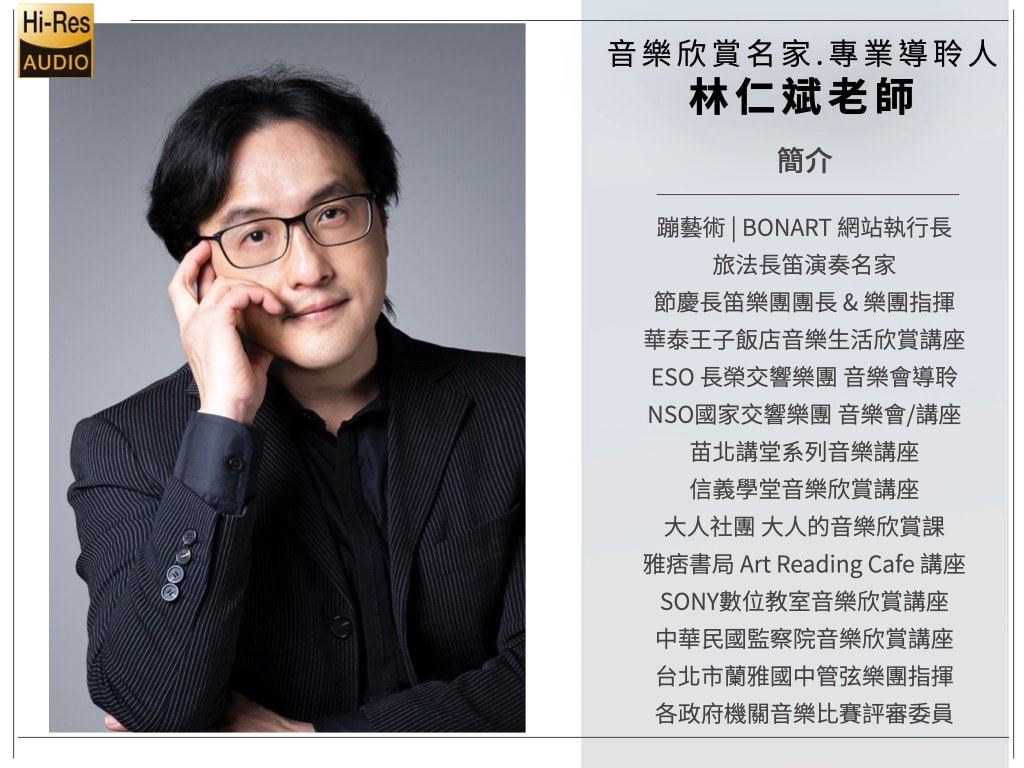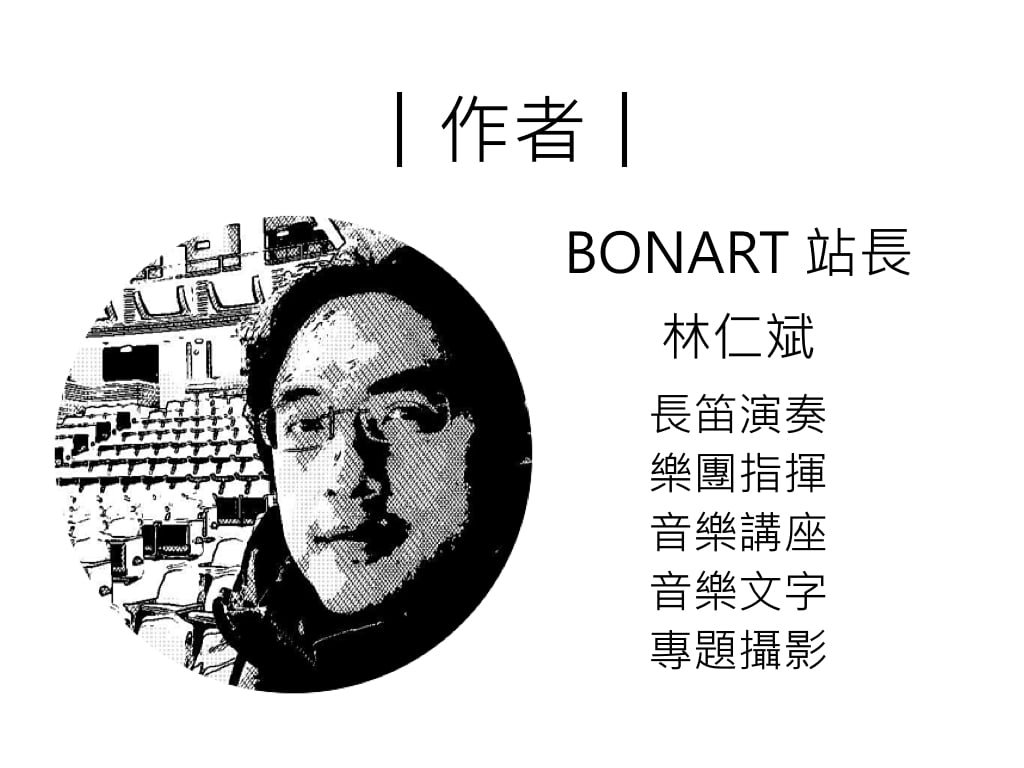【BON音樂】深入認識管弦樂團指揮(三)「Know How V.S. Know Why」以2021年Ammodo指揮大師班為例
Ammodo Conducting Masterclass with Iván Fischer-2
– 資訊整理共享於網路,一起欣賞音樂與藝術之美 –
蹦藝術 | BONART
課程主講:林仁斌
延伸閱讀 林仁斌老師專訪:
布拉姆斯第四號交響曲
第四樂章
變奏曲式
| 第一部分 | 第二部分 | 第三部分 | 第四部分 | 尾聲 – Piu Allegro |
| 0:00 – Theme
0:13 – Var.1 Theme is broken up between horns and strings. 0:25 – V.2 The lower strings play the theme in syncopation, above which the winds begin a smooth, wondering line. 0:40 – V.3 The strings now play the theme on the strong beats, while the wondering line is now detached and more threatening. 0:50 – V.4 The first violins begin a broad, arching melody above syncopated off-beat accompaniment. The theme is in the lower strings and bassoon, played in broken octaves. 1:06 – V.5 The strings elaborate on the broad melody. The winds enter with embellishments in clashing polyrhythms. 1:18 – V.6 The contour of the broad melody is changed so that it arches downward. The accompaniment from winds is sparser. 1:31 – V.7 The violins, again taking the lead, introduce sharp dotted figures. The woodwinds provide responses. The theme in the bass also uses these dotted rhythms. 1:45 – V.8 The violins play rapid oscillation figures, ending with cascading triplet arpeggios. 1:59 – V.9 Essentially an embellished, fierier version of the previous variation. 2:14 – V.10 Very softly, the strings and winds pass the theme between each other. The music starts to lose its edge. 2:32 – V.11 Above the chords of variation 10 (now played in broken octaves by lower strings), a beautiful melody forms for a brief moment, before descending scales take us to the next variation. |
2:51 – V.12 The theme is embedded in the long and beautiful, but somewhat halting flute melody. Other instruments provide short off-beat accompanying chords.
3:28 – V.13 The first variation in a major key. The soft, detached off-beat chords continue, as lines from the flute solo are transformed and passed around the orchestra. The notes of the theme are buried inconspicuously in the musical texture. 4:01 – V.14 The trombones transform the theme into a solemn chorale, broken up by expressive silences. 4:36 – V.15 The chorale continues, now with fuller orchestration. |
5:10 – V.16 The previous variation is cut off mid-sentence, as the theme tragically reappears in minor in its most threatening form.
5:21 – V.17 The winds play agitated two-note phrases beginning on the weak beats. The theme is in the string tremolos. 5:31 – V.18 The string tremolos continue, but the detached phrases are replaced with broad swelling gestures. 5:42 – V.19 Strings and horns now alternate with woodwinds on detached, angular lines. 5:52 – V.20 The previous variation is developed into a line with feverish triplet motion and disorienting syncopation. 6:04 – V. 21 The tension increases greatly here, as the flutes and violins play sweeping upward scales against syncopated horn blasts that obscure the meter. 6:14 – V.22 The dynamics quiet down to pianissimo, as an oscillating triplet figuration passes through the orchestra. The winds play descending syncopated chords. The theme is nowhere to be found. 6:24 – V.23 The relation of the previous variation to the theme is revealed, as the theme distinctly reappears in the horns over a more agitated version of the oscillating triplet figuration. |
6:36 – V.24 The theme is broken up between horn blasts and violins, which hang on to the triplet figuration from the previous variations. The structure is similar to variation 1 but in a drastically different mood.
6:46 – V.25 This variation is similar to variation 2, but again, much more powerful and dramatic. The wondering line is transferred to forceful violins playing in tremolo, while the rest of the orchestra outlines the theme with off-beat triplets. 6:58 – V.26 Similar to variation 3, but in a more sombre state. The oscillating triplets remain in the strings, with the brass, and later winds taking over the melody. 7:10 – V.27 The music once again manages to arrive at a major tonality. The wind section plays long two-note descends harmonized in thirds, with decorative accompaniment from the strings. 7:21 – V.28 The long two-note descends blossom into a beautiful flowing melody, with triplet accompaniment. 7:32 – V.29 This variation marks the start of the music’s tragic turn back to minor. The strings pluck a series of descending thirds on weak beats, while the rising gestures in the winds further distort the bar line. 7:43 – V.30 The descending thirds now take the foreground, played loudly on the strong beats, and in canonic imitation between violins and lower strings. The winds take over the offbeat accompaniment. |
8:01 – The coda marks the point of no return. The tempo speeds up, with the theme ripping the music apart with biting dissonances and cascading string arpeggios. Diminished (sped-up) versions of the theme appear in exhilarating sequences, before a strong V – I cadence affirms the key of E minor, tragically ending the movement. |
最後一個樂章可能是第四號交響曲,除了第一樂章外最引人注目的一段:第四樂章採用了巴洛克時期以來古老的變奏曲是「夏康舞曲」(Chaconne ),也有人認為此變奏曲式為「帕薩加里亞舞曲」(Passacaglia)。
布拉姆斯此「夏康舞曲/帕薩加里亞舞曲」樂章的主題,實際上是來自巴哈清唱劇第150號所使用的主題,稍加以輕微修改。
儘管主題看似簡單——因為其實主題與和聲之設計,本質上是從主音到主音的一個上升的音階片段,然後再回到主音——布勃拉姆斯使用這個簡單的骨架作為後續越來越複雜的主題和聲框架的基礎。
和聲總譜看第四樂章主題:
管弦總譜看第四樂章主題:
第四樂章:欣賞包含樂段分析
Brahms – Symphony no.4 (movement 4): Score and Analysis
從第一個變奏開始,陸續布拉姆斯共寫了大約30段變奏,非常驚人。
這些變奏一段段地增強織度與架構的複雜,並增加了樂曲強度;彷彿不屈不撓地挑戰過去未有的變奏技法,帶著些許受到壓迫的憂鬱感病並持續不段發展。
第四樂章最後的變奏,直接進入尾聲終止式,回到e小調,首尾呼應,並與第一樂章帶來的離別、可能的的悲劇與憂鬱呼應,似乎在這深深的黑暗中,逐漸地步向虛無…
第四樂章(7’16″起)
巴哈:b小調彌撒⟨信經⟩(Credo) – ⟨釘在十架上⟩(Crucifixus)
| 原 文 歌 詞 |
Crucifixus etiam pro nobis,
Sub Pontio Pilato,
Passus et sepultus est.
|
| 中 文 歌 詞 |
祂為了我們被釘在十字架上
在般雀比拉多掌權之時
受難而被埋葬
|
⟨釘在十架上⟩(Crucifixus)
半音音型運用與分析
延伸欣賞
指揮大師班 影片一
Katharina Wincor
指揮大師班 影片二
Jaume Santonja
指揮大師班 影片三
Corinna Niemeyer
指揮大師班 影片四
Martijn Dendievel
伊凡.費雪與大會堂管弦樂團
延伸閱讀
【BON音樂】管弦樂團專題 – 全球十大交響樂團巡禮 World’s Best 10 Symphony Orchestras
下課前看一下小鮮肉…
補充資料
Marin Alsop x NOSPR / masterclass / main session
謝謝您~來到蹦藝術
認識蹦藝術的幾個方法:
1. 加入蹦藝術群組
實體與線上音樂講座訊息、各種音樂分享、優質音樂會折扣碼、精彩藝文旅遊行程…,好康優惠不漏接
加入方式:
請先聯繫蹦藝術林仁斌老師本人,由林老師協助加入專屬課程群組。
https://line.me/ti/p/LB1ro0P0AU
2. 聆聽蹦藝術 – Podcast
蹦藝術Podcast 一鍵通:https://linktr.ee/bonart
3. 贊助蹦藝術(單次或定期定額贊助)
從製播節目到網頁文章撰寫、網站維護,都需要經費,更需要您的贊助
無論是單次贊助,或者定期定額贊助,蹦藝術都感謝您對我們的支持
開卷蹦藝術.享受美好閱讀時光
 一杯咖啡.一點心意.支持蹦藝術
一杯咖啡.一點心意.支持蹦藝術
各類合作提案,聯繫方式:
*手機:0917.670.518
*Line:https://line.me/ti/p/LB1ro0P0AU
*E-mail:jenpin888@gmail.com
更多音樂新知
2025-05-04
受保護的內容: 【BON音樂】林仁斌談2025年荷蘭阿姆斯特丹《馬勒音樂節》:馬勒《大地之歌》”Das Lied von der Erde”
蹦藝術林仁斌老師將以2025年歐洲最盛大之荷蘭阿姆斯特丹馬勒音樂節為緯,每一曲交
2025-05-04
受保護的內容: 【BON音樂】林仁斌談2025年荷蘭阿姆斯特丹《馬勒音樂節》:馬勒《大地之歌》”Das Lied von der Erde”
蹦藝術林仁斌老師將以2025年歐洲最盛大之荷蘭阿姆斯特丹馬勒音樂節為緯,每一曲交
2025-05-04
受保護的內容: 【BON音樂】林仁斌談2025年荷蘭阿姆斯特丹《馬勒音樂節》:馬勒《大地之歌》”Das Lied von der Erde”
蹦藝術林仁斌老師將以2025年歐洲最盛大之荷蘭阿姆斯特丹馬勒音樂節為緯,每一曲交













